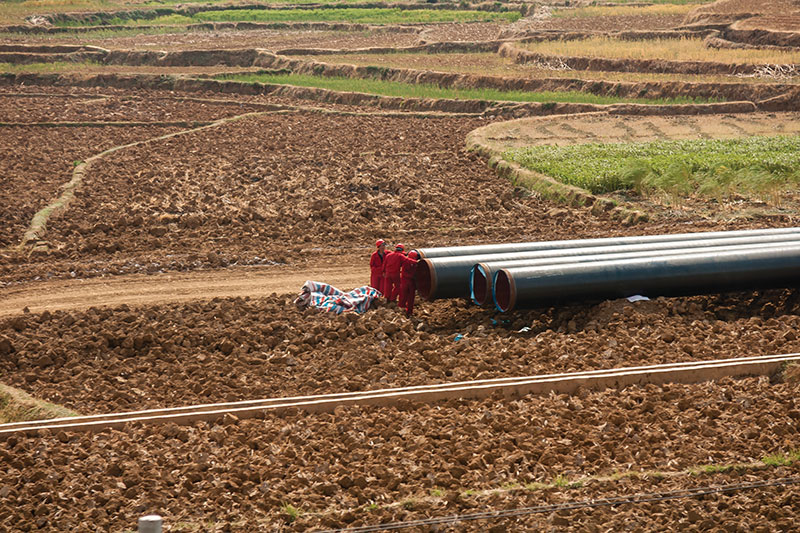April 2020, Vol. 247, No. 4
Features
Part Two: China’s Pursuing Historic Diversification of Pipeline Routes
By Gordon Feller, Energy Writer
Editor’s note: In our second look at China’s pipeline infrastructure, Energy Writer Gordon Feller explores CNPC’s investment of billions of dollars in Kazakhstan´s energy sector and doubts that remain surrounding a final export corridor. (Part One appeared in the January 2020 issue.)
Kazakh oil and Turkmen gas supplies have strategic relevance to China, since these allow Beijing to diminish the heavy reliance on maritime energy routes. Since nearly 70% of China’s energy imports are delivered via oil tankers and liquefied natural gas (LNG) tankers, those maritime options are the primary supply corridors. The development of overland energy import routes from Central Asia, Russia and Myanmar increases China’s energy security.
Kazakhstan and China signed the first truly significant energy cooperation agreement in 2005 – one of the most significant pillars within a bilateral comprehensive partnership – which includes strong political and diplomatic relations as well as deep trade and commercial relations. In 2013, Sino-Kazakh bilateral trade reached $22.53 billion.
The realization of the Atyrau-Alas Hankou oil pipeline, linking the Caspian’s oil-rich fields with Chinese markets through the energy gateway represented by the Xinjiang region, undoubtedly is the most successful result of the Sino-Kazakh energy cooperation. This pipeline has increased its original capacity of 250,000 bpd to 400,000 bpd.
For the Kazakh government, this pipeline is a strategic corridor, which allows the diversification of export routes. The Atyrau-Alas Hankou Pipeline is the only overland Kazakh oil pipeline that does not transit Russian territory – unlike the Caspian Pipeline Consortium (bringing oil from Kazakhstan’s Tengiz oil field to Russia’s Black Sea port of Novorossiysk).
Kazakhstan’s oil exports through the Baku-Tbilisi-Ceyhan (BTC) pipeline are delivered by tankers across the Caspian Sea from the Kazakh Port of Aqtau to the Azerbaijani Port of Baku.
CNPC has invested billions of dollars in Kazakhstan’s energy sector, obtaining contracts for exploration in promising blocks and providing know-how and modern equipment. Between 1997 and 2003, CNPC acquired an 85% stake in AktobeMunaiGas (the fourth-largest oil company in Kazakhstan) and holds a 67% stake in PetroKazakhstan (the remaining 33% belongs to KazMunaiGas, the main Kazakh oil company).
After the state visit of Chinese President Xi Jinping to Central Asia in September 2013, CNPC obtained another significant ownership stake: purchasing 8.33% of the shares in The North Caspian Operating Company, the international consortium developing the giant Kashagan oil field. Kashagan holds the fifth-largest oil reserves in the world, estimated at 13 billion barrels of oil, and its production should reach 1.5 MMbpd in the following phases of development.

Even if some doubts remain about the final export route – westward to the European Union (EU) markets through the BTC pipeline, northward to Russia through the CPC pipeline or eastward to the Chinese markets – China and Kazakhstan aim to realize a new oil pipeline. They want it to be parallel to the existing one, to deliver the growing oil production in the Caspian Sea oil fields (potentially including Kashagan) to China’s growing markets.
In addition to the oil sector, China is also interested in completing the Beyneu-Bozoi-Shymkent Gas Pipeline (BBSGP), which will be connected to the CAGP, which at present is fueled with Turkmen and Uzbek gas. BBSGP will have a capacity of 10 Bcm/year (353 Bcf/year). A joint venture linking CNPC with KazMunaiGas is developing the Urikhtau gas field, in the Caspian’s northeastern section, and this gas has been designated to supply the CAGP’s Kazakh trunk.
CAGP’s initiation in 2009 represented a historic change in the regional energy chessboard, ending the Russian monopoly on Turkmen gas exports (although small volumes of Turkmen gas are exported to Iran). As the Turkmen government reoriented its export routes to China, and the pivot took place, the Turkmen gas exports to Russia fell.
The Sino-Turkmen strategic energy partnership was enhanced through the addition of one new gas pipeline within the China-Central Asia gas pipeline network: Line D, joining the existing Lines A and B and C. Thanks to the rise of production ensured by the exploitation of the Galkynysh giant gas field, Turkmenistan will export 65 Bcm (2.295 Tcf) to Chinese markets by 2020. China granted a loan of $8 billion to start Galkynysh production – and later Beijing’s government ensured an additional loan to Turkmenistan for Galkynysh’s second phase of development.
Even though energy cooperation between China and Central Asia appears profitable for all parties, in the longer term the growing Chinese role in both the Turkmen and Kazakh energy sector could hamper diversification of export energy routes.
Turkmenistan is in an especially risky position in this. All projects to create alternative routes of energy export – such as the Turkmenistan-Afghanistan-Pakistan-India Pipeline (TAPI) and Turkmen participation in the Trans-Caspian gas corridor – are frozen. The causes are twofold: the lack of financial investments and geopolitical issues.
In the latter case, Russia’s opposition to the Trans-Caspian corridor is a major part of the picture, but so, too, is the permanent condition of instability in Afghanistan, which prevents TAPI’s realization. In this scenario, Turkmenistan will become growingly dependent on China as the main supplier for the delivery of gas into China.






Comments